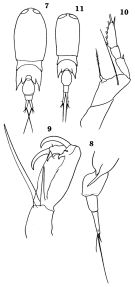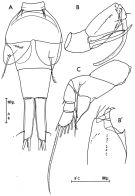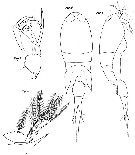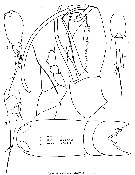|
|
 |
Fiche d'espèce de Copépode |
|
|
Cyclopoida ( Ordre ) |
|
|
|
Corycaeidae ( Famille ) |
|
|
|
Corycaeus ( Genre ) |
|
|
|
Corycaeus ( Sous-Genre ) |
|
|
| |
Corycaeus (Corycaeus) clausi F. Dahl, 1894 (F,M) | |
| | | | | | | Syn.: | Corycäus ovalis : Giesbrecht, 1892 (p.659, figs.F,M)
Corycaeus clausi : Bainbridge, 1972 (p.61, Appendix Table II: vertical distribution); Dessier, 1983 (p.89, Tableau 1, Rem., %); Boxshall & Halsey, 2004 (p.494); Avancini & al., 2006 (p.144, Pl. 112, figs.F,M, Rem.); Lan Y.-C. & al., 2009 (p.1, Table 2, % vs hydrogaphic conditions); Vives & Shmeleva, 2010 (p.204, figs.F,M, Rem.); Isari & al., 2011 (p.51, Table 2, abundance vs distribution); Belmonte & al., 2013 (p.222, Table 2, abundance vs stations); El Arraj & al., 2017 (p.272, table 2, spatial distribution); | | | | Ref.: | | | F. Dahl, 1894 (p.73); M. Dahl, 1912 (p.18, figs.F,M); Pesta, 1920 (p.647, fig.F); Farran, 1929 (p.211, 291, fig.F); Klevenhusen, 1933 (p.590, figs.F, Rem.); 1933 a (p.85, carte 38); Rose, 1933 a (p.327, figs.F,M); Dakin & Colefax, 1933 (p.209); 1940 (p.111, figs.F); Wilson, 1942 a (p.180, fig.F); Lysholm & al., 1945 (p.44); Sewell, 1947 (Rem.: p.274); Tanaka, 1957 (p.79, figs.F,M); Cervigon, 1964 (p.167, figs.F,M); Owre & Foyo, 1967 (p.120, figs.F,M); Vilela, 1968 (p.35, figs.F); Corral Estrada, 1970 (p.236, Rem.); Razouls, 1972 (p.95, Annexe: p.128, figs.F,M); 1974 c (1975) (p.85, figs.F,M); Corral Estrada & Pereiro Muñoz, 1974 (tab.I);; Lakkis & Zeidane, 1987 (p.18, figs.F,M, Rem.); Chihara & Murano, 1997 (p.966, Pl.218: F,M); Boxshall, 1998 (p.221); Bradford-Grieve & al., 1999 (p.888, 974, figs.F,M); Fuentes-Reinés & Suarez-Morales, 2015 (p.369, Table 1, Rem.: p.382, figs.F) |  issued from : O. Tanaka in J. Fac. Agricult. Kyushu Univ., 1957, 11 (1). [Pl.3, Figs.7-11]. Female (from Japanese waters): 7, habitus (dorsal); 8, urosome (lateral left side); 9, A2; 10, P4. Nota: Head and 1st thoracic segment fused. Anterior segment about 1.6 times as long as wide. The abdominal segments and furca in the proportional lengths 46:22:32. Genital segment oval as wide as long (22:23). Anal segment wider at the proximal than at the distal (15:11). Furcal rami more than 3 times as long as it is wide at the proximal. Posterior corners of 3rd thoracic segment extend to 2/3 of the genital segment. Male: 11, habitus (dorsal). Nota: The abdominal segments and furca in the proportional lengths 46:21:33. Genital segment about 2 times as long as wide (7:4). Furcal rami about 7 times as long as it is wide at the proximal (20:3).
|
 issued from : C. Razouls in Vie Milieu, 1974, 24 (1.A). [p.99, Fig.1]. Female (from W Medit.:Banyuls, France): A, 5th troracic segment and urosome (dorsal); B-B', A2.
|
 issued from : C. Razouls in Vie Milieu, 1974, 24 (1.A). [p.100, Fig.2]. Male: A, 5th toracic segment and urosome (dorsal); B-B', A2, C, P4.
|
 issued from : M. Dahl in Ergebnisse der Plankton-Expedition der Humboldt-Stiftung. Bd II, G. f1. I. Die Corycaeinen 1912. [Taf.II, Figs.5-8]. Female: 5, habitus (dorsal); 6, idem (lateral right side); 7, A2; 8, P4.
|
 issued from : M. Dahl in Ergebnisse der Plankton-Expedition der Humboldt-Stiftung. Bd II, G. f1. I. Die Corycaeinen 1912. [Taf.II, Figs.9-12]. Male: 9, habitus (dorsal); 10, idem (lateral right side); 11, A2; 12, P1.
|
 issued from : F. Cervigon iin Mem. Soc. Cienc. nat. La Salle, 1964, 24 (68). [p.168, Lam.3]. As Corycaeus clausi. Female (from Venezuela): 1, habitus (dorsal); 2, abdomen (dorsal); 2, A2; 4, distal part of A2; 5, P4. Nota: lengths ratio genital, anal segments and ciudal rai 49:22:29 and 48:20:32.
|
 issued from : F. Cervigon iin Mem. Soc. Cienc. nat. La Salle, 1964, 24 (68). [p.169, Lam.4]. As Corycaeus clausi. Male: 1, prosome (dorsal); 2, habitus (lateral); 3-4, abdomen (lateral and doral, respectively); 5, A2; 6, P4. Nota: Lengths ratio genital , anal segments and caudal rami 46:21:33; 45:24:31 and 44:24:32.
|
 [O & F] Female: Caudal rami approimately 2/3 the length of the genital segment + anal segment. Male: Caudal rami approximately 1/2 the length of the urosome. [B. & H] Female: Anal somite just longer than wide, at most 1.25 times longer in male. Genital double-somite not projecting over anal somite (in lateral view). Male: Caudal rami 75 % as long as genital somite. [V & S] Female: Caudal rami length less than the abdominal segments (rapport ± 0.8/12). A2 without longitudinal line of spines. Genital segment in regular form, without prominence in dorsal view. Male: Caudal rami length less than the abdominal segments (rapport ± 0.9/14). Anal segment 1.5 times longer than broad. Points of the 3rd thoracic segment exceed 2/3 the genital segment.
|
 Issued from : J.M. Fuentes-Reinés & E. Suarez-Morales in Bol. Invest. Mar. Cost., Santa Marta, Colombia, 44 (2) [p.383, Fig.4]. Corycaeus (Corycaeus) clausi Female (from laguna Navio Quebrado, Colombia): a, habitus; b, A2; c, P4; d, urosome and caudal rami.
| | | | | Ref. compl.: | | | Massuti Alzamora, 1942 (p.105, Rem.); Sewell, 1948 (p.393, 406, 451, Rem.); C.B. Wilson, 1950 (p.193); Fagetti, 1962 (p.51); V.N. Greze, 1963 a (tabl.2); Shmeleva, 1963 (p.141); Duran, 1963 (p.26); Björnberg, 1963 (p.85, Rem.); De Decker & Mombeck, 1964 (p.12); Pavlova, 1964 (p.1711); Shmeleva, 1965 b (p.1350, lengths-volume-weight relation); Pavlova, 1966 (p.45); Furuhashi, 1966 a (p.295, vertical distribution in Kuroshio region, Table 10); Mazza, 1966 (p.74); 1967 (p.367); Ehrhardt, 1967 (p.744, geographic distribution, Rem.); Evans, 1968 (p.12); Dowidar & El-Maghraby, 1970 (p.268); Deevey, 1971 (p.224); Binet & al., 1972 (p.71); Apostolopoulou, 1972 (p.329, 381); Björnberg, 1973 (p.368, 385); Guglielmo, 1973 (p.399); Deevey & Brooks, 1977 (p.156, tab.2, Station "S"); Dessier, 1979 (p.208); Vaissière & Séguin, 1980 (p.23, tab.1); Vives, 1982 (p.296); Kovalev & Shmeleva, 1982 (p.86); Scotto di Carlo & al., 1984 (p.1043); Tremblay & Anderson, 1984 (p.7, Rem.); Regner, 1985 (p.11, Rem.: p.42); Moraitou-Apostolopoulou, 1985 (p.303, occurrence/abundance in E Mediterranean Sea, Rem.: p.310); Jansa, 1985 (p.108, Tabl.I, II, III, IV, V); Brinton & al., 1986 (p.228, Table 1); Jimenez-Perez & Lara-Lara, 1988; Lozano Soldevilla & al., 1988 (p.61); Webber & Roff, 1995 (tab.1); Shih & Young, 1995 (p.76); Suarez-Morales & Gasca, 1997 (p.1525); Böttger-Schnack, 1997 (p.409); Hure & Krsinic, 1998 (p.89, 105); Alvarez-Cadena & al., 1998 (t.1,2,3,4); Suarez-Morales & Gasca, 1998 a (p.112); Lapernat, 1999 (p.33); Siokou-Frangou, 1999 (p.479); Lavaniegos & Gonzalez-Navarro, 1999 (p.239, Appx.1); Dolganova & al., 1999 (p.13, tab.1); Lapernat, 2000 (tabl.3, 4); Suarez-Morales & Gasca, 2000 (1247, tab.1); Seridji & Hafferssas, 2000 (tab.1); Lopez-Salgado & al., 2000 (tab.1); Lapernat & Razouls, 2001 (tab.1); Zerouali & Melhaoui, 2002 (p.91, Tableau I); Vukanic, 2003 (p.139, tab.1); Daly Yahia & al., 2004 (p.366, fig.4); Lan & al., 2004 (p.332, tab.1); Isari & al., 2006 (p.241, tab.II); Marques & al., 2006 (p.297, tab.III); Mageed, 2006 (p.168, Table 4); Lavaniegos & Jiménez-Pérez, 2006 (p.140, tab.2, Rem.); Zervoudaki & al., 2006 (p.149, Table I); Khelifi-Touhami & al., 2007 (p.327, Table 1); Zakaria & al., 2007 (p.52, Table 1, vs Salinity, p.59: Rem.); Marques S.C. & al., 2007 (p.725, Table 1, fig.4, climate variability); McKinnon & al., 2008 (p.848: Tab. IV); McKinnon & al., 2008 (p.843: Tab.1); Lan Y.-C. & al., 2008 (p.61, Table 1, % vs stations);C.-Y. Lee & al., 2009 (p.151, Tab.2); Vidjak & Bojanic, 2009 (p.432, Table II, IV, V); Brugnano & al., 2010 (p.312, Table 2, 3); Drira & al., 2010 (p.145, Tanl.2); Williamson & McGowan, 2010 (p.273, Table 3, Pacific central gyres: N and S); Mazzocchi & Di Capua, 2010 (p.428); Medellin-Mora & Navas S., 2010 (p.265, Tab. 2); Hsiao S.H. & al., 2011 (p.475, Appendix I); Selifonova, 2011 a (p.77, Table 1, alien species in Black Sea); Tutasi & al., 2011 (p.791, Table 2, abundance distribution vs La Niña event); Shiganova & al., 2012 (p.61, Table 4); Salah S. & al., 2012 (p.155, Tableau 1); Uysal & Shmeleva, 2012 (p.909, Table I); Brugnano & al., 2012 (p.207, Table 3); Rekik & al., 2012 (p.336, Table 1, abundabce); Lidvanov & al., 2013 (p.290, Table 2, % composition); Marquez-Rojas & al., 2014 (p.5, Rem., %); Zaafa & al., 2014 (p.67, Table I, occurrence); Benedetti & al., 2016 (p.159, Table I, fig.1, functional characters); Ben Ltaief & al., 2017 (p.1, Table III, Summer relative abundance); Marques-Rojas & Zoppi de Roa, 2017 (p.495, Table 1); Benedetti & al., 2018 (p.1, Fig.2: ecological functional group); Chaouadi & Hafferssas, 2018 (p.913, Table II: occurrence); Palomares-Garcia & al., 2018 (p.178, Table 1: occurrence) | | | | NZ: | 15 | | |
|
Carte de distribution de Corycaeus (Corycaeus) clausi par zones géographiques
|
| | | | | | | | | | | |  issued from : A.A. Shmeleva in Bull. Inst. Oceanogr., Monaco, 1965, 65 (n°1351). [Table 6: 45]. Corycaeus clausi (from South Adriatic). issued from : A.A. Shmeleva in Bull. Inst. Oceanogr., Monaco, 1965, 65 (n°1351). [Table 6: 45]. Corycaeus clausi (from South Adriatic).
Dimensions, volume and Weight wet. Means for 50-60 specimens. Volume and weight calculated by geometrical method. Assumed that the specific gravity of the Copepod body is equal to 1, then the volume will correspond to the weight. |
| | | | Loc: | | | South Africa (E), Congo, G. of Lagos, Ivorian shelf, Dakar, Cape Verde Is., off NW Cape Verde Is., off Morocco-Mauritania, Cap Ghir, Canary Is., off Madeira, Portugal, Mondego estuary, Patagonia, S Brazil, off N Trindade, Barbada Is., Venezuela, Bahia de Mochima & Cariaco Gulf (Venezuela), Caribbean Sea, Jamaica, Caribbean Colombia, Colombia (Laguna Navio Quebrado), Yucatan, G. of Mexico, Cuba, Florida, Sargasso Sea, off Bermuda (Station "S"), off New-York, off E Nova Scotia, Flemish Cap, off W Azores, off W Tangier, Medit. (Alboran Sea, Sidi Fredj coast, Gulf of Annaba, Castellon, Baleares, Banyuls, G. of Lion, Ligurian Sea, Tyrrhenian Sea, Milazzo, Strait of Messina, G. of Gabes, Gulf of Taranto, Malta, Adriatic Sea, Sfax, G. of Gabès, Ionian Sea, Aegean Sea, Thracian Sea, Black Sea, Lebanon Basin, Alexandria, Bardawill Lagoon), SW Indian, China Seas (East China Sea), Taiwan Strait, Taiwan (E, NW), Japan, Japan Sea, Bikini, Kamtchatka, Pacif. (equatorial E & W), California, W BaJa California, La Paz, Gulf of California, W Mexico, Pacific (central gyres: N and S), Australia (New South Wales, North West Cape), Fiji Is., Galapagos-Ecuador, N Chile | | | | N: | 136 | | | | Lg.: | | | (35) F: 1,74-1,5; M: 1,44; (104) F: 1,8; (107) F: 1,5; M: 1,37; (180) F: 1,77-1,6; M: 1,4-1,34; (237) F: 1,7; (327) F: 1,82-1,74; M: 1,56-1,49; (340) F: 1,7; 1,6; M: 1,3; (449) F: 1,57; M: 1,35; (666) F: 1,566; M: 1,35; (668) F: 1,6-1,57; M: 1,36-1,33; (670) F: 1,78-1,55; M: 1,4-1,36; (920) F: 1,58; (1312) F: 1,65; {F: 1,50-1,82; M: 1,30-1,56}
| | | | Rem.: | épi-mésopélagique, 2000 m (off Malte).
Pour Sewell (1947) cette espèce ne serait qu'une variété de C. crassiusculus.
Voir aussi les remarques en anglais | | | Dernière mise à jour : 28/10/2022 | |
|
|
 Toute utilisation de ce site pour une publication sera mentionnée avec la référence suivante : Toute utilisation de ce site pour une publication sera mentionnée avec la référence suivante :
Razouls C., Desreumaux N., Kouwenberg J. et de Bovée F., 2005-2025. - Biodiversité des Copépodes planctoniques marins (morphologie, répartition géographique et données biologiques). Sorbonne Université, CNRS. Disponible sur http://copepodes.obs-banyuls.fr [Accédé le 17 décembre 2025] © copyright 2005-2025 Sorbonne Université, CNRS
|
|
 |
 |












